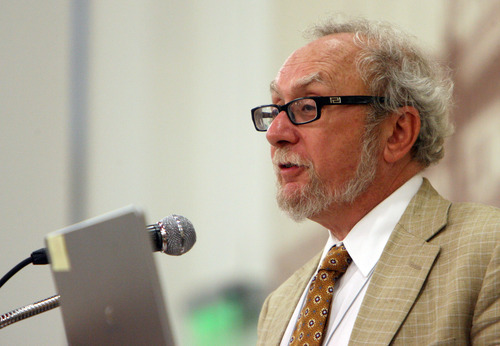This is an archived article that was published on sltrib.com in 2012, and information in the article may be outdated. It is provided only for personal research purposes and may not be reprinted.
Every Republican vying to be the party's 2012 presidential nominee promised to "restore" America to its earlier, supposedly more pure and idealistic self.
Newt Gingrich promised his presidency would "restore America as a nation like no other." Rick Perry wanted to "restore the nation's principles." Ron Paul's 2012 campaign slogan is "Restore America Now" and his platform is called the "Restore America Plan."
And, of course, Mitt Romney's Super-Pac is named: "Restore our Future."
The Tea Party also chose its name to reflect a time in the country's past when they believe clear-eyed patriots fought oppression.
The messages reflect a longing for "an idealized if not utterly mythical America," argues historian and religion scholar Mark Silk. It has a particular resonance for white evangelical Christians and Mormons. But nostalgia alone cannot fully explain why these groups have become "the twin pillars of today's Republican Party."
Their allegiance to the party, Silk believes, is more religious than political. It springs from a "restorationist" perspective on human history, central to both faith traditions.
In its most recent incarnation, restorationism is "a vision of redeeming America by restoring an imagined American past of what are believed to be traditional moral, economic and political values," Silk said in his hourlong speech Wednesday evening to a large crowd gathered at the University of Utah Olpin Student Center. "This restorationist ideal has been central to the religious right from its beginnings, and has come to dominate Republican ideology today."
Silk, director of the Center for the Study of Religion in Public Life at Trinity College in Hartford, Conn, was the keynote speaker on the opening night of the annual Sunstone Symposium, a four-day gathering of Mormon intellectuals.
The need to return to a simpler, and presumably better time, Silk said in his speech, has been a regular impulse repeated in various eras down through time.
Protestants, after all, broke away from Catholicism with the hope of returning to a more pure form of Christianity, unhinged from centuries of tradition. The Puritans wanted to free themselves from involvement with England's state religion to create a truly Christian community.
John Cotton told his flock in 1630, Silk said, that "their new colony had to be in harmony with 'the first Plantation of the Primitive Church.' "
In the 19th century, several religious groups sprung up again to restore Christianity to its pristine or "primitive" form. Those included the Mormons and Landmark Baptists, among others.
Such groups didn't agree on "what exactly was to be restored — doctrinally, organizationally, liturgically and otherwise," Silk said, but had the same desire.
The 1980s brought a "new restorationism," he said, "focused on the revival of America itself."
It was embodied in the presidency of Ronald Reagan, Silk said, who repeatedly applied Jesus' words about believers becoming "the light of the world" and "a city on a hill" to the country itself.
In Reagan's famous 1984 campaign ad, Morning in America, the president implied that under his presidency, Silk said, "the nation had been restored, had experienced a new beginning — or more precisely, was re-experiencing its beginning."
"It's morning again in America," the voice-over intones, as quoted by Silk. "Why would we ever want to return to where we were, less than four short years ago?"
Contemporary Republican politicians repeatedly evoke Reagan's brand of backward-looking optimism, he said, but "restorationism is not a political theory or ideology" with platforms and positions. It is, instead, he said, "a project to recreate the world as its devotees imagine it once was."
Silk believes, he said, that in the LDS Church, "the restorationist impulse has gotten somewhat out of hand."
The 2010 defeat of Utah Sen. Bob Bennett at the hands of Utah's Tea Party and the anti-immigrant posture of the Mormon rank-and-file "have, in my view anyway, gotten in the way of the church's larger religious agenda," Silk said. "The interesting story about the Saints in the coming years, I believe, will have to do with the how this [political] tug-of-war will be resolved — if indeed it is."
Understanding the restorationist impulse, he says, helps explain why Mormons and evangelicals are both drawn to the Republican Party, where they can be political partners while remaining theological competitors.
It also helps "explain the strength, longevity and diversity of the contemporary conservative movement as a whole," Silk said. "Because the movement draws on deep-seated religious impulses, it has lasted longer than any political movement in American history."





